Gas Stations in United States of America - Everything you need to know
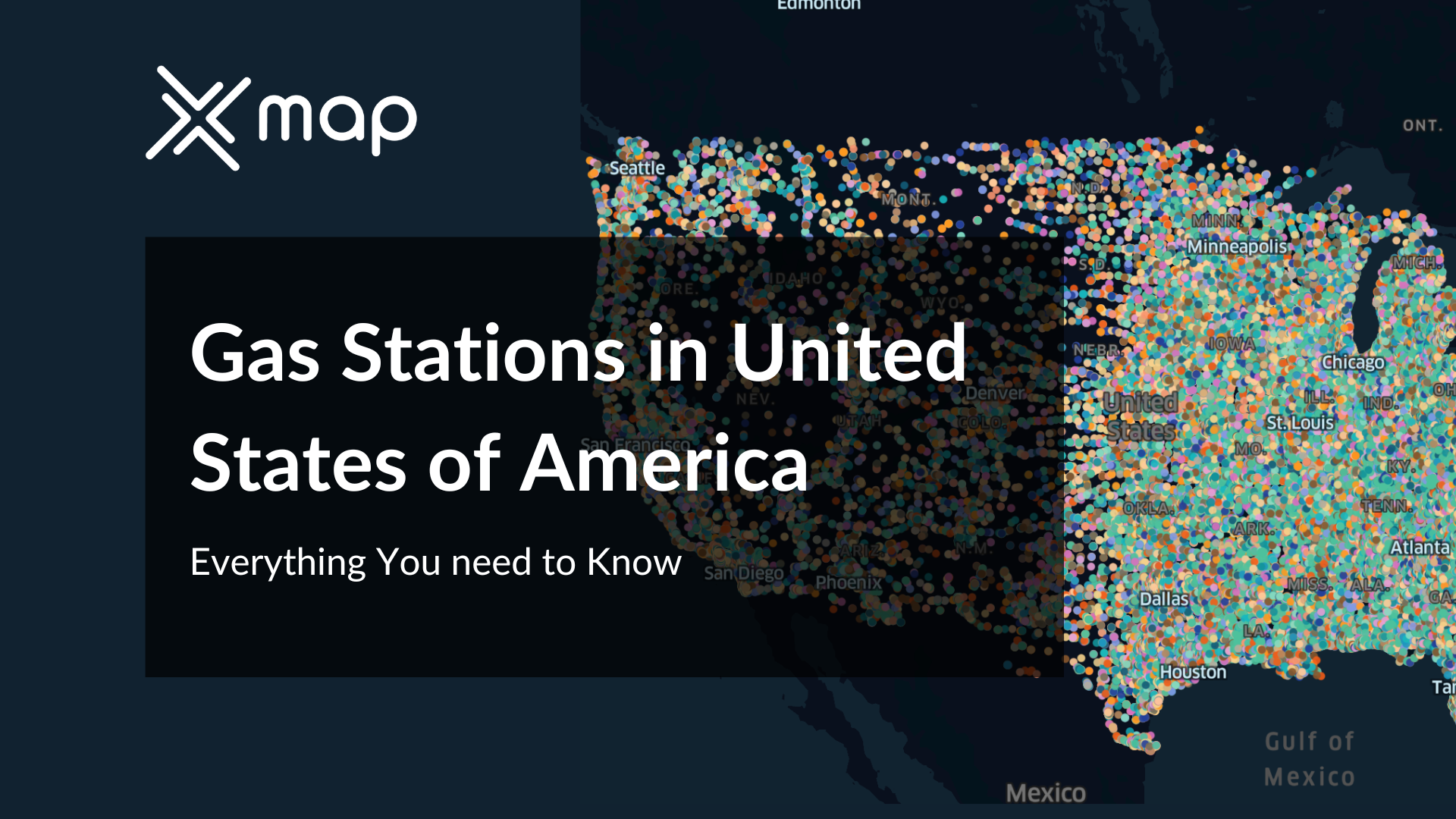

If you are a visionary business leader in the United States, there's no doubt that the incorporation of geographical insights into your decision-making can add that extra strategic edge. The focus here is the vast array of gas stations spread throughout this great country. Furnishing essential data that can enhance your business decisions, optimize your site selection strategies, and support various other applications, geospatial insights hold the keys to propelling your business towards success.
So, how can leveraging these valuable insights help you? Let's delve into the geospatial exploration of USA's gas stations. It's time to elevate your business acumen to another level, and we are here to guide you every step of the way.
The use of geospatial insights in business decision-making is like having a roadmap that not only directs you where to go but also reveals dynamic aspects of the environment you are about to venture into.
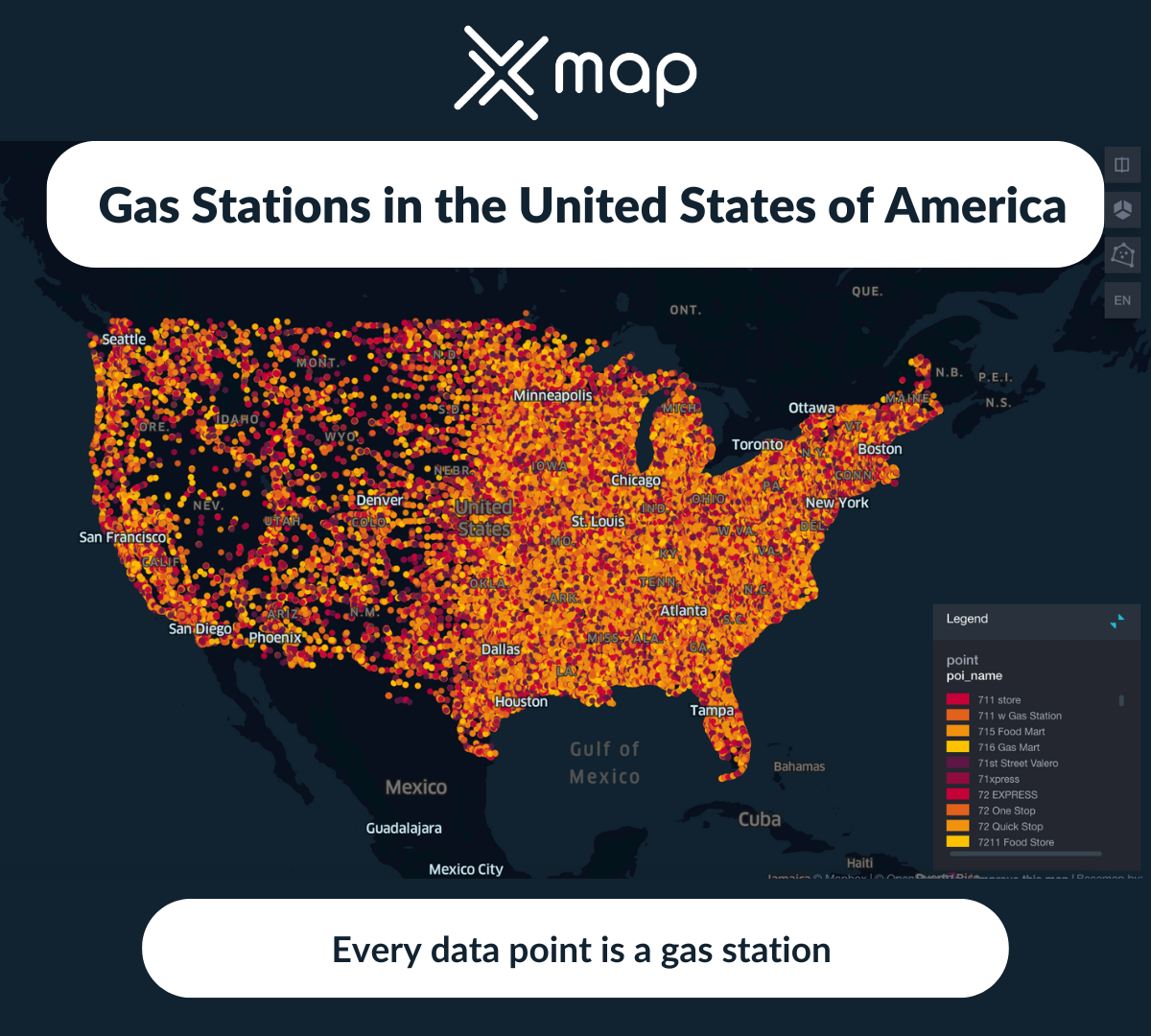
xMap's essential geospatial insight into USA's gas stations reveals an impressive statistic: There are approximately 196,643 retail gas station locations in United States of America (USA).
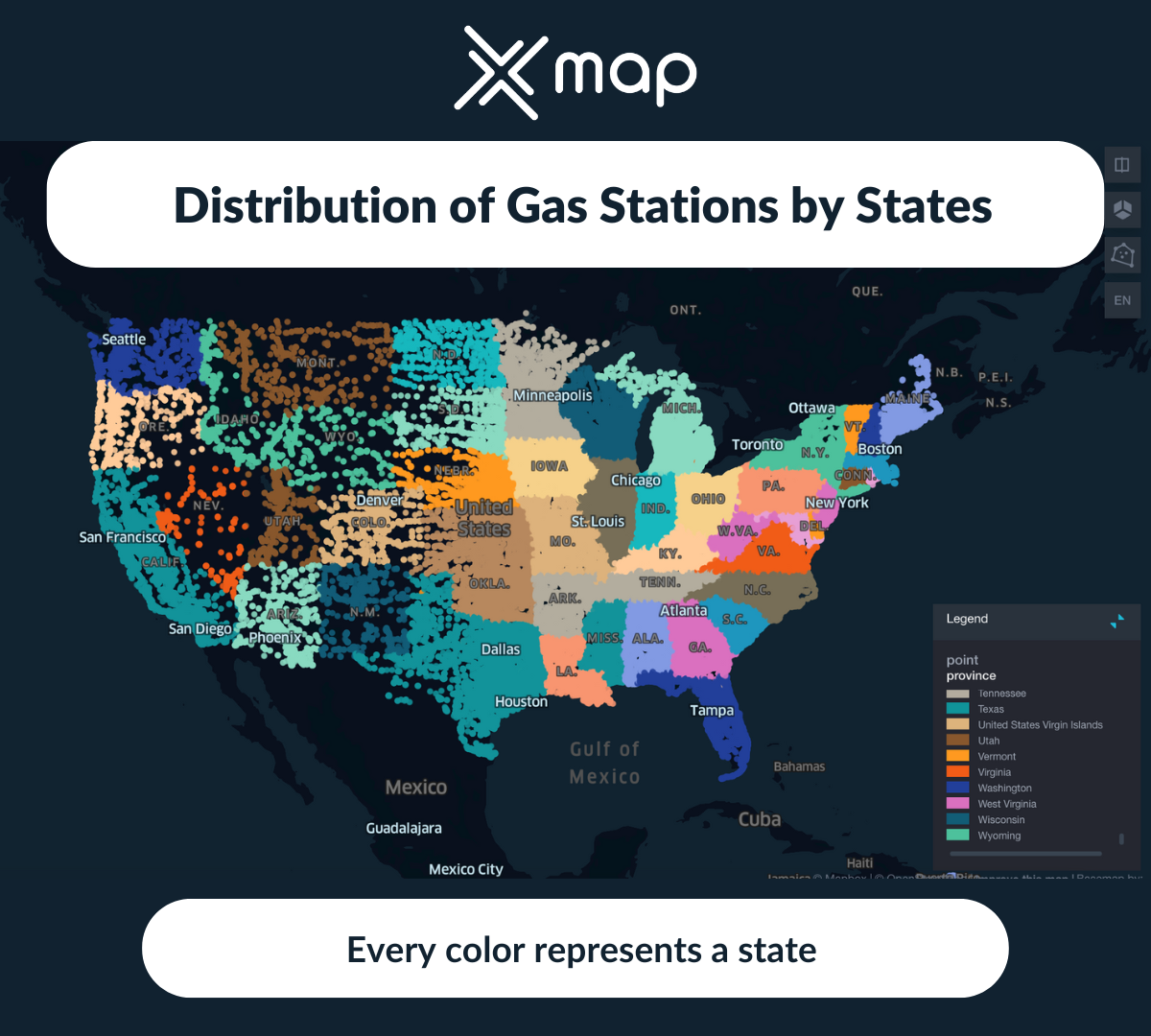
The story of the distribution of U.S gas stations across various states is quite revealing. Not only does it speak to the infrastructure available in each region, but it also provides vital geospatial insights for businesses as they make strategic site selection decisions or seek to understand market dynamics.
Let's consider states characterized by a high density of gas stations. Dense clusters often correspond with high population areas, significant transit routes, or both. In these areas, competition can be fierce, but the demand for fuel is also high. Thus, understanding the spatial distribution can give you a broad overview of the competitive landscape when considering where to establish a new station.

On the other hand, states with fewer gas stations might indicate a different set of factors. They could be largely rural, with lower populations and less demand for fuel. Or, these areas might simply be underserved, presenting a potential opportunity for businesses to fill a market gap.
Let us dive into the details of the states that boast the highest density of gas stations. This data can be insightful for businesses looking to understand the landscape better.
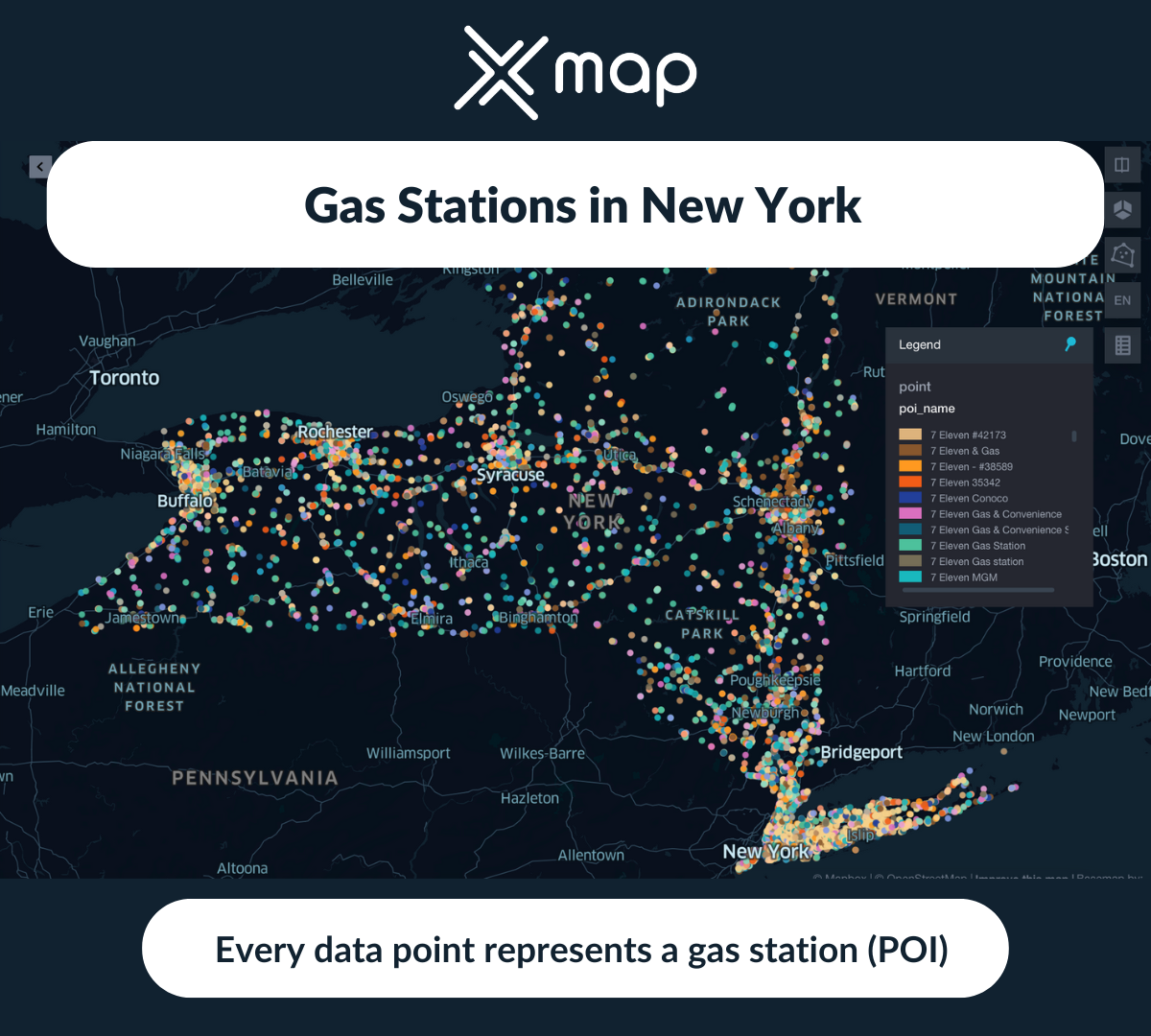
New York carries a substantial amount of weight in the US gas station landscape. Drawing insights from the geospatial analysis, it's clear that their distribution mirrors closely to the population density across various counties. The need for fuel is typically higher in highly-populated, urbanized areas, especially in and around the major cities like New York City, Buffalo, and Rochester.
But what does this mean for your business? You can use this data to not only understand the current market but also to predict potential growth areas. If you find an area where the population is growing but there are few gas stations, that may be a prime location for expansion.

Suffolk County leads with the highest number of gas stations (759), which might indicate a higher demand for automotive fuel, possibly due to a larger geographical area requiring more mobility or a higher number of vehicles.
Nassau and Westchester Counties follow with 535 and 435 gas stations, respectively, suggesting these areas also have significant automotive traffic and possibly a dense population or a high level of commuting to other regions.
Erie, Queens, Monroe, and Kings Counties show a descending order in the number of gas stations. This gradient could reflect variations in population density, urbanization, and the availability of alternative transportation methods (such as public transit in more urban areas like Queens and Kings County).

Deep in the heart of Texas, the fuel station landscape is as expansive as the state itself. With a landscape that ranges from dense urban environments to remote rural territories, Texas holds a unique position in the United States gas station distribution.

Harris County's Dominance: With 3786 gas stations, Harris County leads by a substantial margin. This high number can be attributed to its status as a major economic and population center in Texas, encapsulating Houston, the state's largest city. The demand for gas stations here is likely driven by a combination of high vehicle ownership rates, significant commuter traffic, and a sprawling urban layout.
Major Urban Counties: Dallas, Tarrant (including Fort Worth), and Bexar (encompassing San Antonio) Counties follow Harris in terms of gas station counts. These figures reflect the urban and suburban development patterns of these areas, with dense populations and extensive road networks fostering a high demand for fuel.
Mid-sized Urban Counties: Travis County, home to Austin, and the surrounding counties like Montgomery and Hidalgo show fewer gas stations, which could reflect their smaller populations or possibly more efficient urban planning and public transportation options that reduce the reliance on personal vehicles.
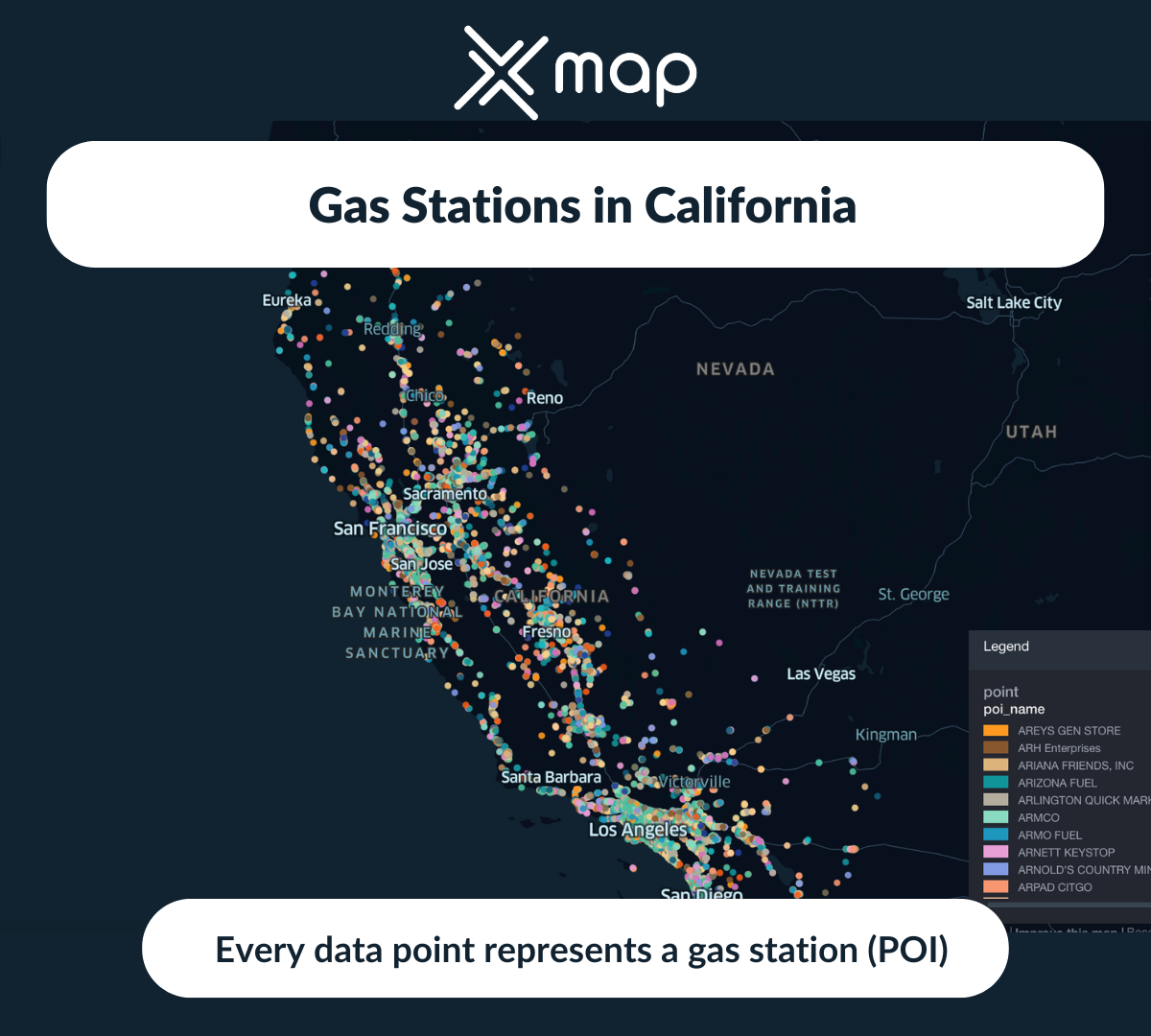
The distribution of Gas Stations in California is not uniform throughout the state. Dense urban areas such as Los Angeles and San Francisco have a higher concentration of both traditional gas stations and electric charging stations compared to more sparsely populated regions. A factor that businesses should bear in mind during site selection.

Los Angeles County's Prominence: Los Angeles County stands out significantly with 2704 gas stations, highlighting its status as a major urban and economic hub. The high number likely reflects its dense population, extensive freeway system, and the central role of car travel in daily life.
Southern California's High Counts: The counties of San Diego, San Bernardino, Orange, and Riverside, all in Southern California, follow Los Angeles in gas station counts. These numbers indicate the heavy reliance on personal vehicles in these sprawling metropolitan areas, which are characterized by significant suburban development and longer commuting distances.
Central and Northern Counties: Kern, Fresno, and Sacramento Counties, representing Central and Northern California, have fewer gas stations. This may reflect their smaller populations, but also possibly the varying degree of urbanization and economic activity compared to the state's southern regions.

The Florida coastline stretches over 1300 miles, making it an ideal spot for gas stations. With heavy tourist activity and frequent sea-connectivity, this area can serve as a lucrative spot for setting up new fuel stations or improving the existing ones.
Another beneficial factor that can influence gas station replication in Florida is the state's high population density. With over 21 million inhabitants and counting, there's a constant demand for fuel stations. Analyzing population density and vehicle sales within specific regions can provide insightful data for strategic decision making concerning the positioning of gas stations.

Miami-Dade County's Leading Position: With 1026 gas stations, Miami-Dade County leads in Florida, indicating a high demand for automotive fuel, possibly due to a combination of high population density, tourism, and extensive commuting patterns in the Miami metropolitan area.
Strategic Importance of South Florida: Broward and Miami-Dade Counties, key components of the South Florida metropolitan area, have a significant number of gas stations. This reflects the area's importance as a hub for both residents and a large number of tourists.
Central and North Florida: Hillsborough (Tampa area), Duval (Jacksonville), and Orange (Orlando) Counties show a strong presence in terms of gas station counts, highlighting the importance of these regions as population and economic centers in central and north Florida.
Tourism Influence: Orange County, home to Orlando and its numerous theme parks and attractions, has a relatively high number of gas stations, which can be attributed to the heavy tourist traffic in addition to the local population's needs.
Variation Across the State: The distribution of gas stations from north to south and on the Gulf coast (e.g., Pinellas and Hillsborough Counties) versus the Atlantic coast (e.g., Palm Beach and Broward Counties) provides insights into regional economic activities, population distribution, and transportation patterns.
Data is king when it comes to making informed decisions about site selection and other critical aspects of your business. Just as you would use customer behavior or sales data to optimize your marketing or operations, geospatial insights serve a similar purpose – albeit a unique one that focuses on location. But what kind of data are we talking about? Let's dive deeper into these crucial geospatial insights that are integral for U.S. gas stations.
Website URLs for gas stations can provide a vast amount of valuable data. By visiting the website of a gas station, businesses can tap into various types of information such as any ongoing promotions, customer service quality, brand affiliations, additional services offered and overall digital presence. Unlike other information, a website URL can give an accurate representation of the gas station's investment in their digital marketing and customer engagement.

Shell's Dominance: With 12,258 gas stations, Shell leads the market, highlighting its extensive reach and potentially indicating a strong brand preference among consumers. Shell's wide network suggests strategic location choices to cover key areas and high traffic locations.
Exxon's Strong Presence: Exxon follows closely with 11,091 gas stations. This substantial footprint signifies Exxon's competitive position in the market, emphasizing its long-standing brand reputation and commitment to accessibility for customers.
BP and Sunoco's Market Share: BP and Sunoco hold significant portions of the market with 6,748 and 6,242 gas stations, respectively. These numbers reflect their strong market presence and strategic efforts to cater to various demographics and regions.
Chevron's Strategic Positioning: Chevron, with 5,934 stations, showcases its strategic placement in the market. Despite being fifth in this list, Chevron's focus on quality with its Techron additive may appeal to a specific consumer segment focused on vehicle performance and fuel quality.
Gas stations in the U.S. have evolved into multi-service facilities that can include convenience stores, fast food restaurants, car washes, or even vehicle repair shops. Understanding what additional services are offered at these gas stations can greatly enhance your decision-making when considering location selection, market positioning, marketing strategies, as well as operational and infrastructure planning.
Shell's Market Leadership: Shell leads significantly with 2,988 gas stations, indicating a dominant market presence. This suggests Shell's strategic choice in locations and potentially a wide consumer base's preference for their services and products.
Exxon's Strong Second: Exxon holds the second position with 1,935 stations, showcasing its robust footprint in the market. This strong presence might reflect Exxon's historical brand strength and strategic investments in locations that ensure high visibility and traffic.
BP and Mobil's Competitive Presence: BP and Mobil have a competitive number of establishments, with 1,279 and 1,235 gas stations, respectively. These numbers highlight their strategic efforts to maintain a significant presence in the market, catering to specific demographics and geographic areas.
Marathon Gas's Solid Market Share: Marathon Gas, with 982 stations, although smaller relative to the leaders, indicates a solid market share. This number reflects Marathon's strategic market positioning and possibly its focus on niche markets or specific geographic regions.

Understanding the ratings data of U.S gas stations can play a crucial role in your business decisions. It lets you gain a more in-depth knowledge about customer satisfaction and public perception about the service quality, fuel prices and additional facilities. This collective wisdom is often a reliable touchstone for evaluating the performance of a station. Ratings can range from 1 to 5 stars, with 5 being the best and 1 the least.

The number of reviews provides an idea of the volume of foot traffic at a particular gas station. More reviews generally indicate a higher number of customers, which in turn shows the station's popularity. For a business deciding on a location for a new establishment, a gas station with a large number of reviews offers a bigger customer base to tap into.

Moreover, the number of reviews can also offer a measure of trustworthiness for a gas station. Most people are likely to trust a gas station with numerous reviews, as it suggests transparency and positive customer interaction. This insight can lead to a better-informed decision when selecting a site.

The majority of gas stations (25,872) are classified as moderately expensive. This suggests that most fuel retailers position their pricing around a mid-range point, possibly to balance affordability with profit margins and cater to a broad customer base.
A significant number of gas stations (13,203) are categorized as inexpensive. This indicates a competitive segment focused on attracting price-sensitive customers, reflecting a strategic choice by some retailers to compete primarily on price.

The presence of phone numbers for 172,969 gas stations underscores the importance of direct communication channels in the fuel retail industry. This indicates that a vast majority of gas stations prioritize customer service and accessibility, allowing for inquiries, service confirmations, and potentially enhancing customer trust and loyalty. This figure also suggests a significant level of operational sophistication and a focus on customer engagement within the industry, enabling consumers to reach out directly for information or assistance.
of possibilities for making data-driven decisions, positioning your business properly, and outsmarting the competition. Let's dive right into it.
Geospatial data, obtained from sources like business registries, meteorological data, traffic patterns, and even social media check-ins, can help identify prime locations for gas stations. This kind of information aids in recognizing areas that have high automobile traffic but few gas stations, so setting up a new one there could result in solid profit margins due to decreased competition.
When planning to set up a site for a new gas station, it’s crucial to make as few errors as possible. Inaccurate location data might lead to establishing a venture in an area already saturated with gas stations or areas with low vehicle traffic. Leveraging geospatial information could help reduce such mistakes, as seen in Moscow, where the underlisted fuel stations due to address errors were identified and corrected, leading to optimal performance.
The use of geospatial insights in site selection is not limited to just the initial setup. Continuous tracking and analyzing of geospatial data can provide useful implications about trade area dynamics, changing traffic patterns, and consumer behavior over time. This information, in turn, can guide the necessary operational changes to drive optimal business performance.
Access to accurate and timely geospatial data can give businesses a significant competitive advantage. By understanding the landscape, identifying gaps, and uncovering patterns that others may miss, businesses can strategically position their gas stations. What's more? It can also help in predicting upcoming trends, thus staying ahead of the curve and planning for the future.
Accurate geospatial data is critical, as illustrated by case studies where minor inaccuracies led to significant errors. Using automated geospatial data processing and real-time location analytics can minimize these errors. Employing Geographical Information Systems (GIS) enables businesses to effectively visualize data, aiding in precise decision-making and optimal site selection for gas stations.
Learning from the emphasis on gas station quality, businesses should focus on offering superior fuel options. Analyzing market trends, customer preferences, and the competitive landscape can guide businesses in aligning their offerings with high standards, ensuring customer trust and loyalty.
The dynamic nature of consumer behavior, traffic patterns, and the marketplace necessitates regular updates to geospatial data. Tools for continually refreshing data ensure that businesses can make informed decisions based on the most current information, mirroring successful strategies in dynamic urban settings.
Experts have provided invaluable insights into specific studies, underscoring the importance of expert knowledge in geospatial data analysis and industry-specific challenges. Engaging with experts can significantly enhance decision-making quality, leveraging deep insights for strategic planning and operational improvements.
The foundation of leveraging geospatial insights lies in collecting and analyzing data, but its true value emerges when these insights lead to action. This approach facilitates the application of geospatial data into tangible business decisions, from selecting new sites to forging strategic partnerships and crafting innovative marketing strategies, ensuring businesses not only understand the landscape but also actively navigate their path to success.
In this ever-evolving business landscape, the geospatial insights of USA's gas stations serve as a vital game-changer. Businesses that leverage these insights effectively are greatly advantaged in their site selection, data-driven decisions, and other applications. This comprehensive guide has illuminated the importance and breadth of this information, from the distribution of gas stations across states to the key data insights and the role of geospatial data in site selection. However, it is important to remember to apply these insights strategically and responsibly, embracing technology for data accuracy, prioritizing quality fuel services, and engaging with industry experts for in-depth analysis and constant improvement.
To obtain a free sample of our United States of America Gas Stations dataset, send us an email — sales@xmap.ai
Or visit our catalog page.
If you’d like to data samples for other countries like Egypt, USA, Switzerland, Japa, Turkey, UAE, and others, please visit our platform and sign up.
Whatever your goal or project size, we will handle it.
We will ensure you 100% satisfication.
"We focus on delivering quality data tailored to businesses needs in the middle east. Whether you are a restaurant, a hotel, or even a gym, you can empower your operations' decisions with geo-data.”